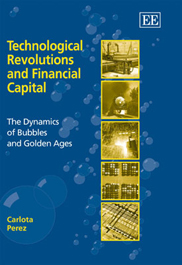Technological Revolutions and Financial Capital
 Cover of the first edition (hardcover) | |
| Author | Carlota Perez |
|---|---|
| Country | United States |
| Language | English, Spanish 2004, Korean 2006, Chinese 2007, Russian 2010 |
| Genre | Non-fiction |
Publication date | April 2003 |
| Media type | Print (Paperback) & ebook |
| Pages | 224 pp |
| ISBN | 1843763311 |
Technological Revolutions and Financial Capital: The Dynamics of Bubbles and Golden Ages is an academic book by Carlota Perez that seeks to describe the connection between technological development and financial bubbles as seen in the emergence of long term technology trends. The model described by Carlota Perez shows repeated surges of technological development over the past three centuries with examples such as: the age of steam and railways, the age of steel and electricity, mass production and the automobile and the current information/knowledge society.[1]
Five technological revolutions[edit]
The book identifies five bursts of technological innovation that have occurred in industrial history.[2][3]
| Technological revolution | New technologies and industries | New infrastructures | Country and year of onset |
|---|---|---|---|
| 1. The industrial revolution | Mechanised cotton industry, wrought iron, machinery | Canals and waterways, water power, turnpike roads | Britain, 1771 |
| 2. Age of steam and railways | Steam engines and machinery, iron and coal mining, rolling stock production | Railways, ports, postal service, city gas | Britain 1829, spreading to Continent and USA |
| 3. Age of steel, electricity and heavy engineering | Cheap steel, full development of steam engine, heavy chemistry, civil engineering, electrical equipment industry, canned and bottled food, paper and packaging | Worldwide shipping, transcontinental railways, worldwide telegraph, telephone, electrical networks | USA and Germany, 1875 |
| 4. Age of oil, automobiles, and mass production | Mass-produced automobiles, cheap oil and fuels, petrochemicals, internal combustion engine for automobiles, tractors, aeroplanes, war tanks, and electricity production, home electrical appliances, refrigerated and frozen foods | Worldwide analogue telecommunications | USA, spreading to Europe, 1908 |
| 5. Age of information and telecommunications | The information revolution, cheap microelectronics, computers, software, telecommunications, control instruments, computer-aided biotechnology, new materials | Worldwide digital telecommunications, the Internet, electronic mail and other e-services, multiple source electricity networks, high-speed multi-modal physical transport links by land, air and water | USA, spreading to Europe and Asia, 1971 |
Financial cycles[edit]
Carlota Perez has found that these cycles of technological revolutions are coupled with financial cycles. Each cycle, which may take 50 – 60 years, consists of the following four phases:[2][3]
Irruption phase: There is an intense funding of innovation in new technologies. Clusters of new revolutionary inventions appear. New industries are established, and the construction of new infrastructure begins.
Frenzy phase: Increased speculation and financialization leads to a decoupling between financial capital and production capital. Capital is invested more in financial innovations than in technological innovations. Asset bubbles are inflated.
Synergy phase: Growing inequality and political unrest. A need for political regulation of the financial sector is acknowledged. Asset bubbles may burst. The link between financial capital and production capital is repaired.
Maturity phase: The market for the new technology begins to become saturated. Social structure and infrastructure have adapted to the new technologies. Opportunities for investment are decreasing. The idle financial capital is moving to new sectors and new regions where it may lay the foundation of the next great surge.
Critical reviews[edit]
A Foreign Affairs review said "A broad-sweep 'think piece' in the Schumpeterian spirit, this book discusses the relationship between major technological innovations and financial booms and busts."[4]
An Economist article summarizes her work, "In her book, “Technological Revolutions and Financial Capital”, Ms Perez traces five boom-and-bust cycles of technological innovation: the industrial revolution; steam and railways; steel, electricity and heavy engineering; oil, cars and mass production; and information technology and telecommunications.[5]
References[edit]
- ^ "CARPEREZ.ORG - Carlota Perez". www.carlotaperez.org.
- ^ a b Perez, Carlota (2002). Technological Revolutions and Financial Capital: The Dynamics of Bubbles and Golden Ages. Cheltenham: Edward Elgar.
- ^ a b Perez, Carlota (2010). "Technological Revolutions and Techno-Economic Paradigms" (PDF). Cambridge Journal of Economics. 34 (1): 185–202. doi:10.1093/cje/bep051.
- ^ "Technological Revolutions and Financial Capital: The Dynamics of Bubbles and Golden Ages". 28 January 2009.
- ^ "Faster, cheaper, better".
